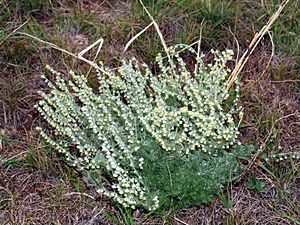Artemisia frigida facts for kids
Quick facts for kids Artemisia frigida |
|
|---|---|
 |
|
| Conservation status | |
| Scientific classification | |
| Genus: |
Artemisia
|
| Species: |
frigida
|
Artemisia frigida is a common flowering plant. It is also known by names like fringed sagebrush, prairie sagewort, arctic sage, and pasture sage. This plant belongs to the sunflower family, which is a very large group of plants. You can find it naturally growing in Europe, Asia, and many parts of North America. In some areas of the United States, it was brought there by people and is now an introduced species.
Contents
About Fringed Sagebrush
Fringed sagebrush is a perennial plant, meaning it lives for more than two years. It has a woody base and its stems spread out. They often form a mat or clump that can grow up to about 40 centimeters (1.3 feet) tall.
What It Looks Like
The stems of Artemisia frigida are covered in soft, gray-green leaves. These leaves have many lobes and are coated in silvery hairs, which makes the plant look a bit fuzzy.
When the plant flowers, it produces many small, round flower heads. Each flower head is about half a centimeter wide. They are covered with woolly, gray-green or brownish leaf-like parts called phyllaries. Inside these flower heads, there are tiny flowers. Some are female flowers (pistillate ray florets) and others are male and female flowers (bisexual disc florets).
This plant has a strong, pleasant smell. It can produce many seeds, which helps it spread. It can also spread by layering, where its stems touch the ground and grow new roots.
Where It Grows
Artemisia frigida is very common in many places, especially in dry areas or places where the ground has been disturbed. It grows a lot in the Rocky Mountains and Great Plains in North America. You can find it in grasslands, areas with shrubs, and woodlands.
Sometimes, this plant grows a lot in areas that have been heavily grazed by animals like cows or sheep. If there's too much fringed sagebrush, it can sometimes mean that the land has been overgrazed. While some ranchers see it as good food for their animals, others think it's a weed that causes problems.
Animals and the Plant
Many wild animals eat Artemisia frigida. For example, white-tailed jackrabbits and sage grouse are known to munch on this plant.
Uses of the Plant
People also use Artemisia frigida in different ways.
- Gardening: It is grown in gardens because of its pretty foliage (leaves). It has even won an award called the Royal Horticultural Society's Award of Garden Merit.
- Landscaping: Because it can handle dry conditions, it's used in landscaping and to help stop erosion (when soil washes away). It's also used to help bring back plants to rangelands.
- Traditional Uses: Indigenous peoples of North America have used Artemisia frigida for many purposes.
- The Blackfoot people used it as medicine for coughs, colds, wounds, and heartburn. They also used its crushed leaves to help revive gophers during a game.
- The Cree people used it for headaches and fevers.
- The Tewa people used it for stomach problems like gastritis and indigestion.
- The Zuni people made a tea from the whole plant for colds. They also used sprigs of the plant in special dances and planted them with corn, hoping it would help the corn grow well.
See also
 In Spanish: Artemisia frigida para niños
In Spanish: Artemisia frigida para niños


